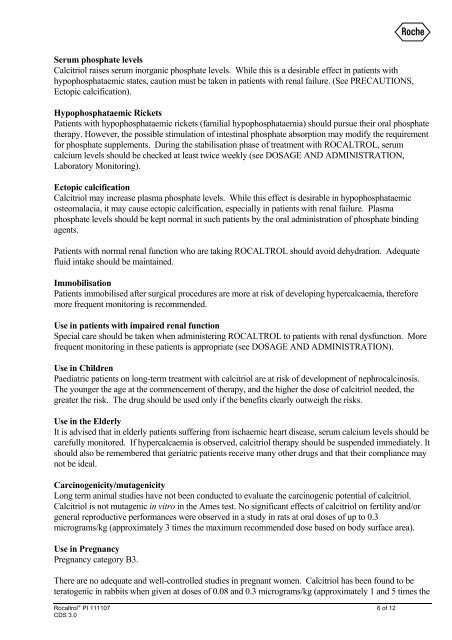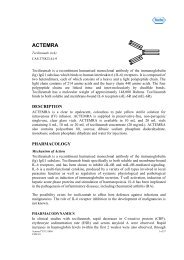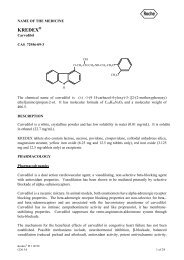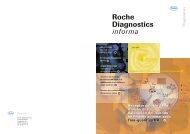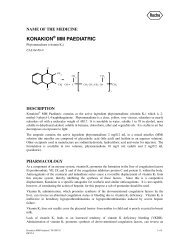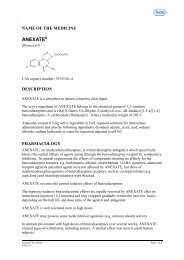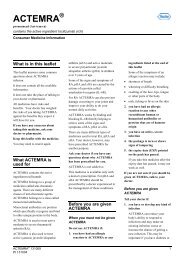Rocaltrol (calcitriol) - Product Information (PI) - Roche Australia
Rocaltrol (calcitriol) - Product Information (PI) - Roche Australia
Rocaltrol (calcitriol) - Product Information (PI) - Roche Australia
You also want an ePaper? Increase the reach of your titles
YUMPU automatically turns print PDFs into web optimized ePapers that Google loves.
<strong>Rocaltrol</strong> ® <strong>PI</strong> 111107 6 of 12<br />
CDS 3.0<br />
R<br />
Serum phosphate levels<br />
Calcitriol raises serum inorganic phosphate levels. While this is a desirable effect in patients with<br />
hypophosphataemic states, caution must be taken in patients with renal failure. (See PRECAUTIONS,<br />
Ectopic calcification).<br />
Hypophosphataemic Rickets<br />
Patients with hypophosphataemic rickets (familial hypophosphataemia) should pursue their oral phosphate<br />
therapy. However, the possible stimulation of intestinal phosphate absorption may modify the requirement<br />
for phosphate supplements. During the stabilisation phase of treatment with ROCALTROL, serum<br />
calcium levels should be checked at least twice weekly (see DOSAGE AND ADMINISTRATION,<br />
Laboratory Monitoring).<br />
Ectopic calcification<br />
Calcitriol may increase plasma phosphate levels. While this effect is desirable in hypophosphataemic<br />
osteomalacia, it may cause ectopic calcification, especially in patients with renal failure. Plasma<br />
phosphate levels should be kept normal in such patients by the oral administration of phosphate binding<br />
agents.<br />
Patients with normal renal function who are taking ROCALTROL should avoid dehydration. Adequate<br />
fluid intake should be maintained.<br />
Immobilisation<br />
Patients immobilised after surgical procedures are more at risk of developing hypercalcaemia, therefore<br />
more frequent monitoring is recommended.<br />
Use in patients with impaired renal function<br />
Special care should be taken when administering ROCALTROL to patients with renal dysfunction. More<br />
frequent monitoring in these patients is appropriate (see DOSAGE AND ADMINISTRATION).<br />
Use in Children<br />
Paediatric patients on long-term treatment with <strong>calcitriol</strong> are at risk of development of nephrocalcinosis.<br />
The younger the age at the commencement of therapy, and the higher the dose of <strong>calcitriol</strong> needed, the<br />
greater the risk. The drug should be used only if the benefits clearly outweigh the risks.<br />
Use in the Elderly<br />
It is advised that in elderly patients suffering from ischaemic heart disease, serum calcium levels should be<br />
carefully monitored. If hypercalcaemia is observed, <strong>calcitriol</strong> therapy should be suspended immediately. It<br />
should also be remembered that geriatric patients receive many other drugs and that their compliance may<br />
not be ideal.<br />
Carcinogenicity/mutagenicity<br />
Long term animal studies have not been conducted to evaluate the carcinogenic potential of <strong>calcitriol</strong>.<br />
Calcitriol is not mutagenic in vitro in the Ames test. No significant effects of <strong>calcitriol</strong> on fertility and/or<br />
general reproductive performances were observed in a study in rats at oral doses of up to 0.3<br />
micrograms/kg (approximately 3 times the maximum recommended dose based on body surface area).<br />
Use in Pregnancy<br />
Pregnancy category B3.<br />
There are no adequate and well-controlled studies in pregnant women. Calcitriol has been found to be<br />
teratogenic in rabbits when given at doses of 0.08 and 0.3 micrograms/kg (approximately 1 and 5 times the


